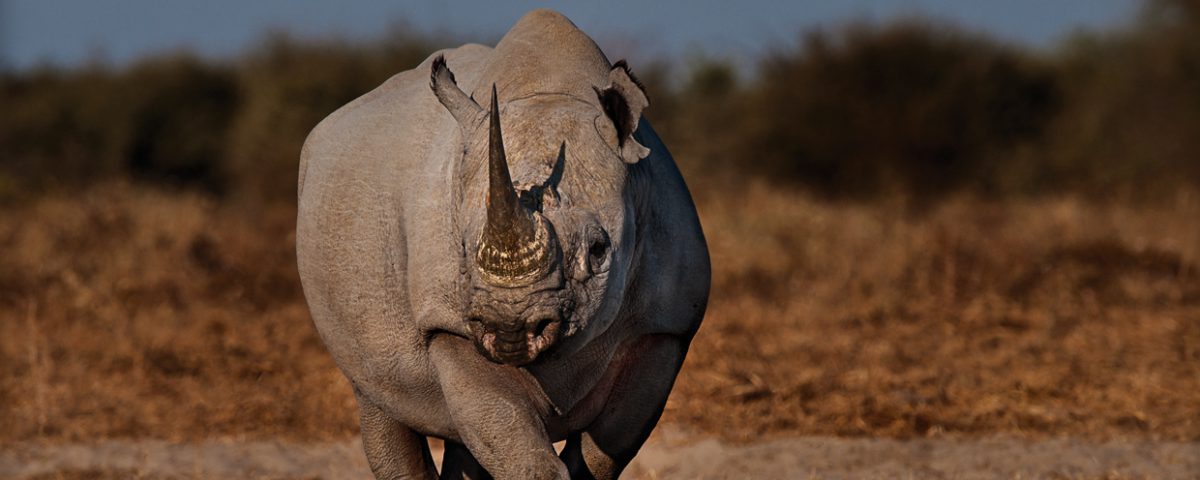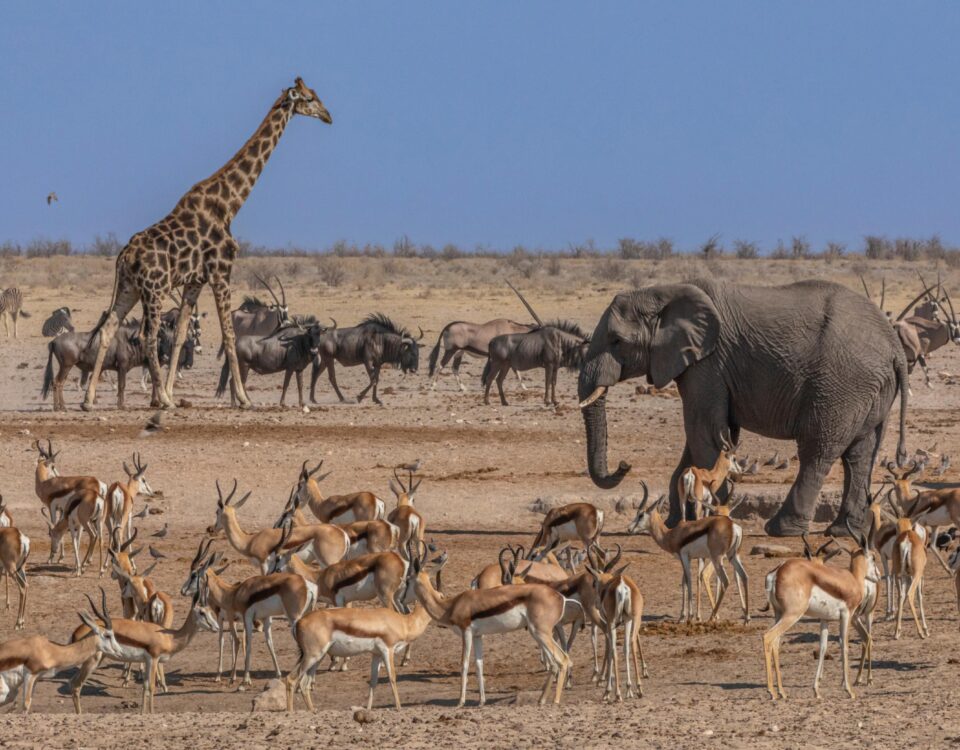Main photo ©Paul van Schalkwyk

Hunting dangerous game in remote places
July 29, 2016
Bergzicht Game Lodge
July 13, 2017An incident that highlights the ‘ugly surprise factor’ imminent in encounters with dangerous game happened earlier this year on a farm that borders the Etosha National Park. Text Ralf Kröling
T he farm is a partner in the black-rhino conservation programme of the Namibian Government and hosts three adult black rhino bulls. On the morning of 21 June, PH Tim Osborne, a highly experienced professional, was guiding a client on a hunt for plains game.
They came across some old rhino tracks and droppings, then after progressing for another 40 metres or so, Tim suddenly became aware of a rhino bull standing in a thicket only 10 metres away. As a result of the strong wind blowing, the bull could not hear or smell the hunters, but had seen them. Rhinos dislike human scent and their normal reaction is avoidance. But under these circumstances, the bull launched an immediate charge.
Tim had just enough time (and presence of mind) to push his client behind a tree for cover, but since there was no other tree close by, he started to run. The rhino bull was on him in split seconds and from here on his memory is a bit fuzzy. At first the rhino knocked him down and crushed his chest. Then the furious animal gored Tim and flipped him into the air, so that he landed with his back on the rocks. The rhino stopped the attack but didn’t leave, just stood watching the scene from about 40 metres away.
The hunter rushed to Tim, enquiring anxiously whether he was ‘all right’. Tim answered with a question (and irony) of his own: “Was that spectacular, or what?” Fortunately Tim’s backpack had protected his back from the hard landing, but his pelvis had been shattered and his rib cage completely torn away from his sternum. The biggest threat was the hernia caused to Tim’s intestines being gored by the rhino.
Fortunately, the hunting party was carrying a cellphone and a GPS. Tim’s wife Laurel was informed immediately, and she went into alpha mode to organise the rescue of her husband. She knew about a game capture company nearby that operated a wing of five helicopters. Unfortunately, not one of them was available. Laurel finally found help at Expedite Air in Tsumeb, which immediately sent its Jet Long Ranger medivac chopper to the rescue.

Tim Osborne, one of the first professional hunters to join the custodianship programme, is a regular contributor to Huntinamibia.
Meanwhile, Tim was still lying on the rocks, the sun beating down on him. His client was doing his best to shade and comfort him, while the threat of the rhino bull that was still hovering close by and kept staring at them never let off. About an hour later, assistance from the farm arrived, and the rhino, disturbed by the vehicles, took off. With direct cellphone contact to the pilot, the chopper was guided precisely to the spot, where he landed at 14:30.
With an Emergency Medical Technician on board, professional help had arrived. Tim was stabilised with oxygen and a drip, and airlifted to the closest airstrip that could handle an ambulance aircraft, which fortunately was only 20 km away at Epacha. The SOS King Air was already waiting and an hour later, Tim was delivered to the emergency room of the Roman Catholic Hospital in Windhoek. After two weeks in the Intensive Care Unit and many threatening complications, Tim turned the corner and embarked on the road to recovery. When he returned to the farm, he could walk on crutches and now his daily exercise is a two-kilometre walk on the farm.
RHINO CUSTODIANSHIP PROGRAMME
___________________________________________________
In 1993 the Namibian Government, with the help of local communities and conservation organisations, launched the Rhino Custodianship Programme.
The programme functioned on the principle that although the rhinos would remain government property, local landowners and traditional authorities residing in conservancies would take over the protection, monitoring and care of these animals.
Since this model of conservation was launched, both the black and white rhino populations in Namibia have increased, with Namibia being home to one of the largest black rhino populations in the world.
The custodianship programme has demonstrated that translocation of critically endangered wildlife onto private or communal land could be a vital tool for conservation.
“By offering communities the benefits derived from tourism, the value of a living rhino far outstrips the opportunities offered by poaching.”
The key was value addition. By offering communities the benefits derived from tourism, the value of a living rhino far outstrips the opportunities offered by poaching.
And it has worked. From barely 50 individuals in the early 1980s, Namibia’s rhino population continues to expand. And as a result, Namibia has become a prime rhino-watching destination globally.
For further information, visit www.travelnewsnamibia.com
This article was first published in the HUNTiNAMIBIA 2013 issue.


